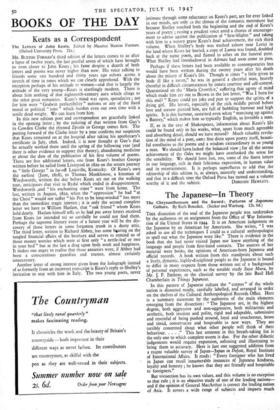The Japanese—In Theory
THIS dissection of the soul of the Japanese people was undertaken by the authoress on an assignment from the Office of War Informa- tion of the United States in 1944. It is an American judgement on the Japanese by an American for Americans. She writes, " I was asked to use all the techniques I could as a cultural anthropologist to spell out what the Japanese were like." There is evidence in the book that she had never visited Japan nor knew anything of the language and people from first-hand contacts. The sources of her material were books, the opinions of American-born Japanese and official records. A book written from this standpoint about such a lively, dynamic, highly-disciplined people as the Japanese is bound to differ in many respects from those written out of a background of personal experiences, such as the notable study Suye Mura, by Mr. J. F. Embree, or the classical survey by the late Basil Hall Chamberlain in Things Japanese.
In this pattern of Japanese culture the " corpus " of the whole nation is dissected neatly, carefully labelled, and arranged in order on the shelves of the Cultural Anthropological Records Office. Here is a summary statement by the authoress of the main elements emerging from the dissection: " The Japanese are, in the highest degree, both aggressive and non-aggressive, both militaristic and aesthetic, both insolent and polite, rigid and adaptable, submissive and resentful of being pushed around, loyal and treacherous, brave and timid, conservative and hospitable to new ways. They are terribly concerned about what other people will think of their behaviour. " This last sentence in this breath-taking list is the only one to which complete assent is due. For the other didactic judgements would require expansion, softening and illustrating to bring them to accuracy. Here is just one suggested addition from a recent valuable survey of Japan—Japan in Defeat, Royal Institute of International Affairs. It reads : "Every foreigner who has lived in japan can recall innumerable instances of Japanese kindness, loyalty and honesty ; he knows that they are friendly and hospitable to foreigners."
But vivisection has its own values, and this volume is no exception to that rule ; it is an objective study of one of the leading nations— and if the opinion of General MacArthur is correct the leading nation of Asia. It covers a wide range of subjects and imparts much
information. The first chapter, Assignment : Japan, might have been omitted without any great loss to the value of the volume. It is mainly concerned with an exposition of the materials on which a cultural anthropologist works, and in setting forth the value of the subsequent findings. The remaining chapters, eleven in number, range over a wide field of subjects, and gather into one many observations made by writers on all things Japanese relevant to the writer's main object ; they form a valuable summary for consultation. But the compiler's deductions as a cultural anthropologist from these summaries would not always commend the approbation of one who had lived among and with the Japanese over a good stretch of years. There is something in a living corpus that you can't dissect and tabulate. But there is a value in neat parcels carefully labelled, duly documented and scientifically arranged on shelves alongside other dissected national souls.
The last chapter, The Japanese since 177-Day, makes accessible and brings into focus a good deal of valuable material. It rightly eulogises that great soldier and administrator, General MacArthur. Forecasts of Japan's possible future are reasonably based on her reactions to the present rule of the General and his efficient staff.
The glossary at the end of the volume needs revision, e.g., the first word in it is " Ai," and this is given in English as " love, specifically a superior's love of a dependant." " Ai " is the common term in Japanese colloquial for love ; but it is not confined in ordinary speech to the love of superior to inferior. It is used widely of all aspects of love, e.g., love of country, love of one's neighbour, and in such exhortations as, ".Let us love one another." If it is kept in mind by the English reader that this book was written by an American for Americans ; that it is assumed all through that Japanese culture comes out as a second best as compared with the American ; and that the future of Japan lies solely in American hands, much about Japanese culture tnd character may be gleaned from it.
S. HEASLETT.



































 Previous page
Previous page